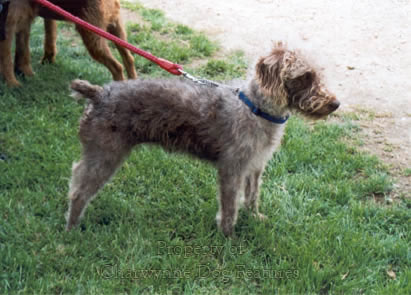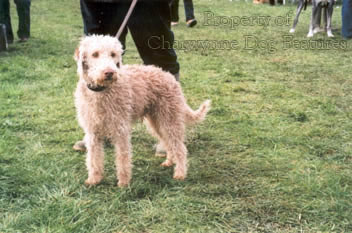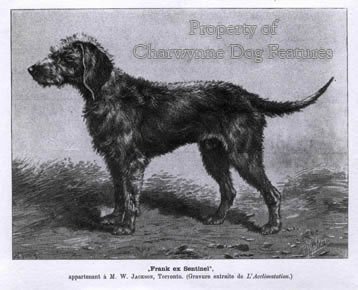656 Bedlington Blood
THE BEDLINGTON LURCHER
by David Hancock
 The breed title of Bedlington Terrier does scant justice to such a capable all-round hunting dog; if anything the Bedlington is a pedigree lurcher, whose blood is much valued by lurcher men. As a breed, the ancestry of the Bedlington is, relative to most breeds, well-documented and free from myths. From the celebrated hunt terriers, Peacham and Pincher of Edward Donkin of Rothbury to the nailors' terriers in the Northumbrian village of Bedlington itself, from Joseph Ainsley's dog and Christopher Dixon's bitch and their offspring, the prototype Piper and Coate's Phoebe, came the foundation of the breed. Mention is sometimes made of the use of blood from small Otterhounds, Bull Terriers and an infusion of Whippet too, in the development of the breed. But little reference is made to the origin of the distinctive topknot, the highly-individual linty coat and the range of self-colours in the breed.
The breed title of Bedlington Terrier does scant justice to such a capable all-round hunting dog; if anything the Bedlington is a pedigree lurcher, whose blood is much valued by lurcher men. As a breed, the ancestry of the Bedlington is, relative to most breeds, well-documented and free from myths. From the celebrated hunt terriers, Peacham and Pincher of Edward Donkin of Rothbury to the nailors' terriers in the Northumbrian village of Bedlington itself, from Joseph Ainsley's dog and Christopher Dixon's bitch and their offspring, the prototype Piper and Coate's Phoebe, came the foundation of the breed. Mention is sometimes made of the use of blood from small Otterhounds, Bull Terriers and an infusion of Whippet too, in the development of the breed. But little reference is made to the origin of the distinctive topknot, the highly-individual linty coat and the range of self-colours in the breed.
There was a dog with a topknot and a tight linty-twisty coat in light liver on the Berwick coast and up into the Cheviot Hills at the time the early types of Rothbury Forest Dog were emerging. It was known locally as the Tweed Water Spaniel, but Tweed Water Dog would have been more accurate. Water Spaniels have the marcelled coat texture, as the American Water Spaniel illustrates. Water Dogs have the 'poodle-coat' as the Italian, the Spanish and the Portuguese Water Dogs demonstrate. Water dogs have long been favoured by the gypsy community, with gypsy families like the Jeffersons, the Andersons and the Faas, living in the Rothbury Forest at the start of the 19th century. They were famous for their terriers, long-dogs and water dogs. I believe that the distinctive coat of the Bedlington comes from a water dog origin.
In the 19th century, a show held by the old British Kennel Association featured a water-rescue competition, which was won, not surprisingly, by a Newfoundland. But a Bedlington won the third prize and was equal second in the speed trial. In a letter to The Field in 1869, a correspondent stated that 'the Bedlington Terrier is fast, and whether on land or water is equally at home'. In his valuable book 'Sporting Terriers' Pierce O'Conor wrote that 'Bedlingtons are invariably fine water dogs and have wonderful noses. They are the ideal water-side hunters...' From Squire Trevelyan's Old Flint, a dog whelped in 1782, we have inherited over the last two centuries a unique breed of sporting dog, with earthdog instincts and a race-track capability. It is hardly surprising to find lurchermen valuing their blood. They can look like lambs but perform like lions.
Bedlingtons from working lines can look very different from their show ring counterparts, where over-coiffeuring can spoil the appearance of what is essentially a sporting breed. Breed devotees like Ken Bounden have striven to minimize this, whilst working line advocates like George Newcombe, Harry Marsden, Les White, Stuart Staley and Margaret Williamson long warned against too much beautification. My main worry however is not the coat but the curv e! The breed's back has a natural arch over the loin, but it is vital that this is over the loin and not further forward, affecting the power of the dog's movement. This breed must gallop with the whole body and never feature a short back. The arch over the loin is balanced by the tuck-up on the underside, giving a distinct sighthound look to the breed.
e! The breed's back has a natural arch over the loin, but it is vital that this is over the loin and not further forward, affecting the power of the dog's movement. This breed must gallop with the whole body and never feature a short back. The arch over the loin is balanced by the tuck-up on the underside, giving a distinct sighthound look to the breed.
The coat colour is officially blue, liver or sandy, with or without tan, but I see blacks at country shows and whites at foreign shows. All five of these gene pool colours are classic water dog colours. It is of interest that a misalliance between a Sealyham bitch and a Bedlington has produced four pups, rather like the old Rothbury type Bedlingtons. Two were blue and tan and the other two blue; not one was mainly white, like the Sealyham. The early blues in the breed were described as blue-black. Blue is the dominant colour, liver is recessive. We seem to have lost the rich tan once in the breed, perhaps when so many blue and tans were exported in the 1930s out of prejudice against them here. The 'Gutch Common' coat of Margaret Williamson's kennel was once famous in the breed for its harshness and waterproof qualities. 
What does the Bedlington bring to lurchers possessing their blood? Unusually in a terrier breed the Bedlington has the hare-foot, but can also suffer from cracked pads, a hereditary defect indicated by corny outgrowths and deep fissures on the pads themselves, not exactly desirable in a running dog. Copper toxicosis has blighted the Bedlington breed, but to their credit, the show breeders are striving to reduce its incidence.
They can also bring a weatherproof coat and the feisty terrier temperament, although Brian Plummer has written: '...the Bedlington Terrier is a far cry from the tigerish terriers described by Rawdon Lee or the do-or-die terriers bred by Ainsley.' Ted Walsh once wrote: 'An owner of working Bedlingtons has to use tact at all times and avoid situations where jealousy can lead to fighting.' 
In a letter to the sporting press some thirty years ago, Brian Plummer also wrote: 'Three generations of 'Pools of Glenridding', Anthony, John and Eddie, always resorted to mating their fell terriers to game Bedlingtons to incease the courage and determination of their dogs...Dobson of the Eskdale and Ennerdale Foxhounds used chocolate-coloured Bedlington terriers to mate his strain of fell terriers.' But some lurcher breeders favour Bedlington blood because it blends well with Whippet blood, the latter taking some of the feistiness away perhaps, the resultant lurcher is a silent worker, not giving tongue when in pursuit of quarry. The gypsies who lived near my boyhood home usually mated lurcher to lurcher, but brought in Bedlington blood about every fifth generation to 'get the poaching dog'!
Lurcher breeders resorting to the blood of show Bedlingtons should note the words of the 2009 Crufts judge for this breed: 'I am greatly concerned at the lack of quality currently being shown...Bedlingtons should not be short-coupled, a few had very narrow fronts; poor hind movement was prevalent.' A few years before that, the Crufts judge reported: 'Some were rather shelly, lacking muscle tone and very soft. Wheel backs, shallow briskets, round ribs and narrow chests were all evident.' And the Kennel Club tells us that these are 'the best of the very best'! As always in livestock breeding, it is the selection of breeding material which matters not just its source. Bedlington Terrier blood offers a great deal to the lurcher mix but only proven valued blood, rated by knowledgeable breeders rather than possessing what on paper looks like a good dog. You mate your precious bitch to a chosen sire not to its breed.